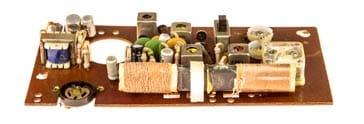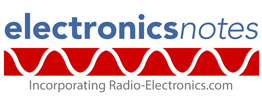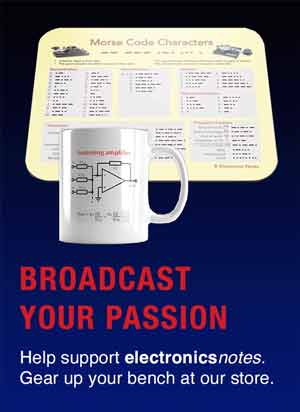Ferrite Rod Antenna: ferrite bar aerial
Notes about the ferrite rod antenna or ferrite bar aerial, a form of RF antenna that is widely used in RFID and portable transistor radio applications.
Home » Antennas & Propagation » this page
Ferrite rod antenna includes:
Ferrite rode antenna basics
The ferrite rod aerial or ferrite bar antenna is a form of RF antenna that is almost universally used in portable transistor broadcast receivers as well as many hi-fi tuners where reception on the long, medium and possibly the short wave bands is required.
As the popularity and listeners of long, medium and short wave broadcasting decreases, as there are higher quality services available via VHF FM and digital services, this sector is decreasing.
However ferrite rod antennas are being used increasingly in wireless applications in areas such as RFID. Here the volumes of antennas required is huge. The antennas for RFID need to be compact and effective, making the ferrite rod antenna or ferrite bar aerial an ideal solution.

Ferrite rod antenna basics
As the name suggests the antenna consists of a rod or bar made of ferrite which is an iron based magnetic material.
A coil is would around the ferrite rod or bar and this is brought to resonance using a variable tuning capacitor contained within the radio circuitry – typically within the RF stages of the radio receiver with which it will be used. In this way the antenna can be tuned to resonance.

In this diagram the ferrite rod antenna is seen as the inductor and core at the input (left hand side) of the circuit. The signal is passed from this into the transistor which acts as an RF amplifier, mixer and also an oscillator – the inductor assembly linking the emitter and collector forms this. The tuning capacitor is mechanically linked or ganged with the RF antenna ferrite rod tuning. Finally the signal reaches the IF transformer and the signal enters the intermediate frequency or IF chain.
As the antenna is tuned it usually used to provide RF tuning circuit for the receiver, enabling both functions to be combined and use the same components. This reduces the number of components needed and hence this provides a cost saving within the radio set.

Typically ferrite rod antennas often have two coils – dependent upon the location, these might be for the long and medium wave broadcast bands.
The ferrite rod antenna operates using the ferrite material to "concentrate" the magnetic component of the radio waves through the pick-up coil. This is brought about by the high permeability µ of the ferrite. It means that the ferrite rod antenna has a much greater level of sensitivity than if the coil had been used on its own.
The fact that this RF antenna uses the magnetic component of the radio signals in this way means that the antenna is directive. It operates best only when the magnetic lines of force fall in line with the antenna.
This occurs when the ferrite rod antenna is at right angles to the direction of the transmitter. This also means that the antenna has a null position where the signal level is at a minimum when the antenna is in line with the direction of the transmitter.

Ferrite rod antenna performance
This form of RF antenna design is very convenient for portable applications and this is its great benefit. However convenience is traded for efficiency – the efficiency of the ferrite rod antenna is much less than that of a larger RF antenna. The performance of the ferrite also limits the frequency response.
Normally this type of RF antenna design is only effective on the long and medium wave bands, but it is sometimes used for lower frequencies in the short wave bands although the performance is significantly degraded, mainly arising from the losses in the ferrite. This limits the operation of ferrite rod antennas to frequencies of 2 or 3 MHz.
Ferrite rod antennas are normally only used for receiving. They are rarely used for transmitting anything above low levels of power in view of their poor efficiency. They can be used as a very compact form of transmitting antenna for applications where efficiency is not an issue and where power levels are very low. If power levels rise too high then heat dissipation in the ferrite becomes an issue.
As they are very much more compact than other forms of low or medium frequency RF antenna, this can be an advantage, and as a result they are being used in applications such as RFID.
Ferrite rod parameters and specifications
There are a number of ferrite rod parameters that are of key interest when considering their use in any radio circuit design.
The two main parameters are the Q of the tuned circuit, and the radiation resistance. These two ferrite rod parameters govern the areas in which they can be used and the design of the circuits in which they are used.
As with any electronic circuit design, the choice of the various parameters for the ferrite rod antenna may require some compromises, but generally a good level of performance can be achieved within the overall limits of this type of antenna.

• Ferrite rod antenna Q parameter
The Q or quality factor of the overall circuit in which the ferrite rod antenna coil of maintained is important in any radio design. The circuit design should have a high Q at the frequencies over which the ferrite rod antenna operates if it is to operate efficiently.
At frequencies of a few hundred kilohertz, a medium permeability material would be used within the ferrite rod antenna and this would enable a Q of about 1000 to be obtained. With a Q of this value it will mean that the antenna circuit will need tuning if it is to operate over more than a single channel or frequency.
When used in a portable receiver, the tuning can be linked to the overall receiver tuning and indeed the ferrite rod antenna normally provides the input tuning for the set. Typically two section ganged tuning capacitors are used in traditional radio sets, although modern sets are likely to use two electronically tuned circuits, steered by the same or nearly the same control voltage.
The Q levels of the overall ferrite rod antenna may appear very high, and in fact the ferrite in a rod form has a much higher Q than the basic material as a result of the fact that the rod forms an open magnetic circuit.

• Radiation resistance of a ferrite rod antenna
One of the advantages of using a ferrite in the antenna is that it brings the radiation resistance of the overall antenna to a reasonable level. This is of considerable importance in any antenna and hence circuit design.
The ferrite rod antenna can be considered as a very small loop antenna. In view of its size, the loop is very much less than a wavelength in length and without the ferrite it would have a very low radiation resistance. Accordingly the losses due to the resistance of the wire would be exceedingly high. Placing the ferrite core in the coil has the effect of raising the radiation resistance by a factor of µ2. This brings the value into more acceptable limits and reduces the resistive losses caused by the wire.
While the introduction of the ferrite rod raises the radiation resistance of the antenna, it does introduce other losses. The ferrite itself absorbs power because energy is required to change the magnetic alignment of the magnetic domains inside the granular structure of the ferrite. The higher the frequency, the greater the number of changes and hence the higher the loss. It is for this reason that ferrite rod antennas are not normally used above frequencies of a few MHz.
The ferrite rod antenna is a particularly useful form of RF antenna design despite its limitations and drawbacks in terms of efficiency, top frequency and the need for tuning. Nevertheless ferrite rod antennas are widely used, being used almost universally as the RF antenna in portable radios for long and medium waveband reception as well as being used in a number of RFID applications.
 Written by Ian Poole .
Written by Ian Poole .
Experienced electronics engineer and author.
More Antenna & Propagation Topics:
EM waves
Radio propagation
Ionospheric propagation
Ground wave
Meteor scatter
Tropospheric propagation
Antenna basics
Cubical quad
Dipole
Discone
Ferrite rod
Log periodic antenna
Parabolic reflector antenna
Phased array antennas
Vertical antennas
Yagi
Antenna grounding
Installation guidelines
TV antennas
Coax cable
Waveguide
VSWR
Antenna baluns
MIMO
Return to Antennas & Propagation menu . . .



